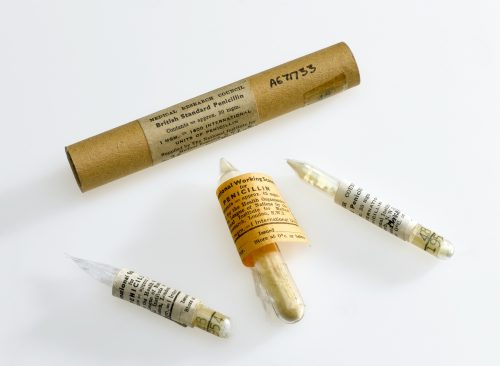Image courtesy of Wikimedia Commons.
Since the discovery of penicillin, the first commercialized antibiotic, in 1928, our society has dramatically improved. We have raised life expectancy, improved quality of life, and altogether created a healthier world. However, it’s not just us who have adapted. Bacteria have entered a new age as well, one characterized by increasing resistance to the antibiotics we create. Antibiotic resistance was first observed in 1947, around six years after commercial production of penicillin began. Since then, the problem has become much more widespread. This poses a scary new problem for us. In the future, might it be possible for an infected piercing or scrape to bring us to our deathbeds? Worldwide, scientists have been working tirelessly to prepare for when our main line of defense finds itself compromised. While studying antibiotic-producing bacteria known as actinomycetes, researchers in the Wright lab at McMaster University in Canada stumbled upon possible solutions: two new functional antibiotics, and a way to predict more.
All this was a result of mapping ancestry. Rather than directly searching for a new antibiotic, Wright’s research team sought to investigate more broad-ended ideas. The motivating factor was a simple question: “What are the origins of antibacterial resistance?” Wright said. Many antibiotics, including penicillin, are derived from biological organisms. Wright and his team first sought out ancestral history of the antibiotic properties of actinomycetes, bacteria found in soil that manufacture many of our current antibiotics. Actinomycetes derive their antibiotic-producing capabilities from biosynthetic gene clusters (BGCs)—groups of two or more genes that, coupled together, encode a pathway for the production of a specific metabolite, such as a product with the antibiotic properties we need. The researchers first gathered sequences of antibiotic BGCs from multiple actinomycete species. Then, they began slowly building phylogenetic trees—diagrams mapping out evolutionary relationships—of the BGCs, looking for a common ancestor. As this effort advanced, they noticed previously untapped antibiotic BGCs. This gave rise to another fundamental question: “Where dothese things come from?” Wright asked.
As the researchers continued to investigate, they found that some of these newly discovered gene clusters encoded products that blocked bacteria in entirely different ways than existing antibiotics. These genes could then be purified and expressed—taken from the bacteria in question and “shown [without other genes] in the way,” Wright said—to create new antibiotics. The researchers had found a way to predict possible antibiotics derived from actinomycetes.
Due to this mapping, they were able to specifically find two new functioning glycopeptide antibiotics: complestatin and corbomycin. Glycopeptide antibiotics combat bacteria by binding to peptidoglycan, an important substance that makes up cell wall. Complestatin and corbomycin have a novel mode of action. Unlike other antibiotics, which prevent the bacterial cell wall from being built, complestatin and corbomycin keep it from being broken down, a critical step during bacterial reproduction. As a result, the targeted bacteria cannot divide and increase their numbers, and their harmful properties are blocked. In mouse models, complestatin and corbomycin diminished infection while maintaining a low rate of resistance development, a promising sign in this early stage of research.
Wright’s team faced several challenges on the way. For one, the mere act of constructing phylogenetic trees presented difficulties, as they had to comb through many genetic sequences to find the links proving their evolutionary relationships. Similarly, challenges also arose in purifying and expressing these genes once they were identified. The researchers faced a game of trial and error, changing a range of conditions to investigate their effects on the production of functional antibiotics by the bacteria. It was “like fishing in a pond,” Wright said; in this case, they were looking for a rather small fish in a very large pond.
Where will this new discovery head? “Our plan is to continue to look for new antibiotics of this new family,” Wright said, noting that his lab has already identified several potential leads. He also hopes to extend the methods used in this paper to investigate another antibiotic family. “We have not yet decided on which one, but we are very hopeful that the method will uncover new compounds,” Wright said.
Antibiotic resistance, especially today, is a larger problem than you might envision. A world where antibiotics no longer work is a world where a small cut could have a prognosis as foreboding as cancer. We have to start looking at more creative ways to solve this growing crisis. Wright’s team has begun thinking outside the box already, which begs the question: what can we expect next?
Citations:
Culp, E.J., Waglechner, N., Wang, W. et al. Evolution-guided discovery of antibiotics that inhibit peptidoglycan remodelling. Nature 578, 582–587 (2020). https://doi.org/10.1038/s41586-020-1990-9

